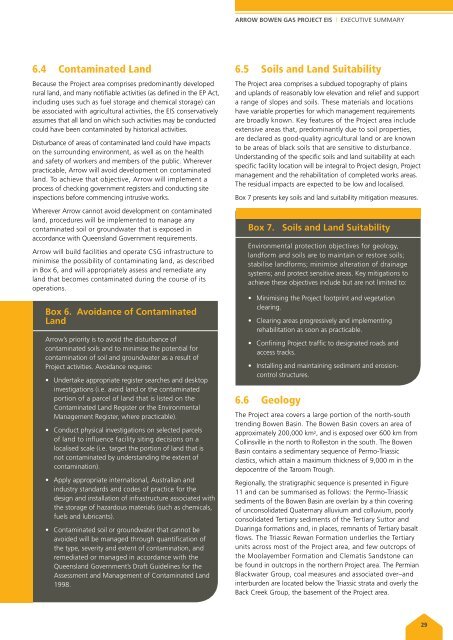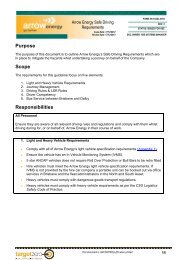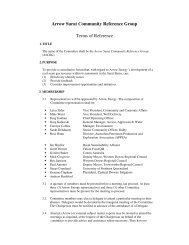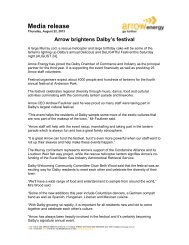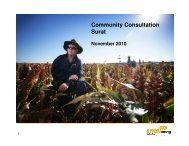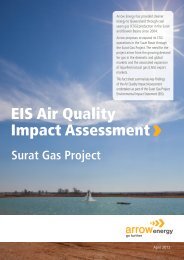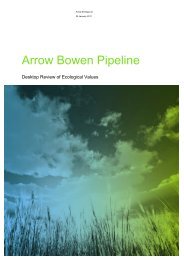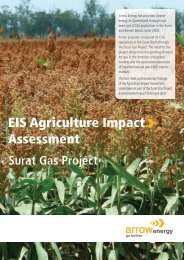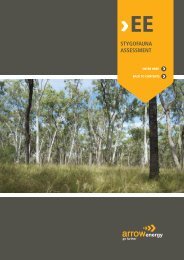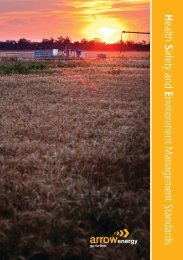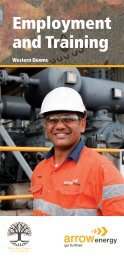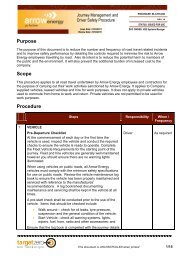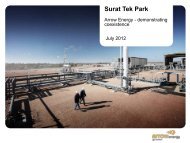Arrow Bowen GAs Project - Arrow Energy
Arrow Bowen GAs Project - Arrow Energy
Arrow Bowen GAs Project - Arrow Energy
Create successful ePaper yourself
Turn your PDF publications into a flip-book with our unique Google optimized e-Paper software.
<strong>Arrow</strong> <strong>Bowen</strong> Gas <strong>Project</strong> EIS | Executive summary<br />
6.4 Contaminated Land<br />
Because the <strong>Project</strong> area comprises predominantly developed<br />
rural land, and many notifiable activities (as defined in the EP Act,<br />
including uses such as fuel storage and chemical storage) can<br />
be associated with agricultural activities, the EIS conservatively<br />
assumes that all land on which such activities may be conducted<br />
could have been contaminated by historical activities.<br />
Disturbance of areas of contaminated land could have impacts<br />
on the surrounding environment, as well as on the health<br />
and safety of workers and members of the public. Wherever<br />
practicable, <strong>Arrow</strong> will avoid development on contaminated<br />
land. To achieve that objective, <strong>Arrow</strong> will implement a<br />
process of checking government registers and conducting site<br />
inspections before commencing intrusive works.<br />
Wherever <strong>Arrow</strong> cannot avoid development on contaminated<br />
land, procedures will be implemented to manage any<br />
contaminated soil or groundwater that is exposed in<br />
accordance with Queensland Government requirements.<br />
<strong>Arrow</strong> will build facilities and operate CSG infrastructure to<br />
minimise the possibility of contaminating land, as described<br />
in Box 6, and will appropriately assess and remediate any<br />
land that becomes contaminated during the course of its<br />
operations.<br />
Box 6. Avoidance of Contaminated<br />
Land<br />
<strong>Arrow</strong>’s priority is to avoid the disturbance of<br />
contaminated soils and to minimise the potential for<br />
contamination of soil and groundwater as a result of<br />
<strong>Project</strong> activities. Avoidance requires:<br />
• Undertake appropriate register searches and desktop<br />
investigations (i.e. avoid land or the contaminated<br />
portion of a parcel of land that is listed on the<br />
Contaminated Land Register or the Environmental<br />
Management Register, where practicable).<br />
• Conduct physical investigations on selected parcels<br />
of land to influence facility siting decisions on a<br />
localised scale (i.e. target the portion of land that is<br />
not contaminated by understanding the extent of<br />
contamination).<br />
• Apply appropriate international, Australian and<br />
industry standards and codes of practice for the<br />
design and installation of infrastructure associated with<br />
the storage of hazardous materials (such as chemicals,<br />
fuels and lubricants).<br />
• Contaminated soil or groundwater that cannot be<br />
avoided will be managed through quantification of<br />
the type, severity and extent of contamination, and<br />
remediated or managed in accordance with the<br />
Queensland Government’s Draft Guidelines for the<br />
Assessment and Management of Contaminated Land<br />
1998.<br />
6.5 Soils and Land Suitability<br />
The <strong>Project</strong> area comprises a subdued topography of plains<br />
and uplands of reasonably low elevation and relief and support<br />
a range of slopes and soils. These materials and locations<br />
have variable properties for which management requirements<br />
are broadly known. Key features of the <strong>Project</strong> area include<br />
extensive areas that, predominantly due to soil properties,<br />
are declared as good-quality agricultural land or are known<br />
to be areas of black soils that are sensitive to disturbance.<br />
Understanding of the specific soils and land suitability at each<br />
specific facility location will be integral to <strong>Project</strong> design, <strong>Project</strong><br />
management and the rehabilitation of completed works areas.<br />
The residual impacts are expected to be low and localised.<br />
Box 7 presents key soils and land suitability mitigation measures.<br />
Box 7. Soils and Land Suitability<br />
Environmental protection objectives for geology,<br />
landform and soils are to maintain or restore soils;<br />
stabilise landforms; minimise alteration of drainage<br />
systems; and protect sensitive areas. Key mitigations to<br />
achieve these objectives include but are not limited to:<br />
• Minimising the <strong>Project</strong> footprint and vegetation<br />
clearing.<br />
• Clearing areas progressively and implementing<br />
rehabilitation as soon as practicable.<br />
• Confining <strong>Project</strong> traffic to designated roads and<br />
access tracks.<br />
• Installing and maintaining sediment and erosioncontrol<br />
structures.<br />
6.6 Geology<br />
The <strong>Project</strong> area covers a large portion of the north-south<br />
trending <strong>Bowen</strong> Basin. The <strong>Bowen</strong> Basin covers an area of<br />
approximately 200,000 km 2 , and is exposed over 600 km from<br />
Collinsville in the north to Rolleston in the south. The <strong>Bowen</strong><br />
Basin contains a sedimentary sequence of Permo-Triassic<br />
clastics, which attain a maximum thickness of 9,000 m in the<br />
depocentre of the Taroom Trough.<br />
Regionally, the stratigraphic sequence is presented in Figure<br />
11 and can be summarised as follows: the Permo-Triassic<br />
sediments of the <strong>Bowen</strong> Basin are overlain by a thin covering<br />
of unconsolidated Quaternary alluvium and colluvium, poorly<br />
consolidated Tertiary sediments of the Tertiary Suttor and<br />
Duaringa formations and, in places, remnants of Tertiary basalt<br />
flows. The Triassic Rewan Formation underlies the Tertiary<br />
units across most of the <strong>Project</strong> area, and few outcrops of<br />
the Moolayember Formation and Clematis Sandstone can<br />
be found in outcrops in the northern <strong>Project</strong> area. The Permian<br />
Blackwater Group, coal measures and associated over–and<br />
interburden are located below the Triassic strata and overly the<br />
Back Creek Group, the basement of the <strong>Project</strong> area.<br />
29


